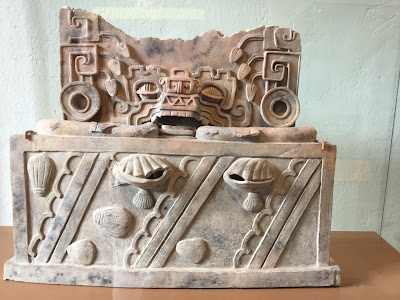Guanajuato City in central Mexico was named a "World Heritage City" in 1988. Its colorful personality is like vivid gemstones fused through centuries of geo-political heat and pressure.
Its name is from an early indigenous language, “Quanax huato," which means “hilly place of frogs."


Frogs are not as common as they used to be, nor are the metals, including silver and gold (lead, copper, iron, tin, and mercury) that drew miners.
The first people known to live here were the Otomi and they called it Mo-o-mi, "the place of metals." Legend suggests that the area was so rich in minerals that, at one time, gold rocks could be picked up off the ground.
Layered with colorful tradition and violent history, Mexican culture has evolved over the last five hundred years creating a unique blend of Native American and European that we know as modern-day Mexican.
In Pre-Columbian times, the central plateau of Meso-America held numerous nomadic tribes with areas devoted to agriculture. Toltecs and Aztecs knew metal-working and used gold, silver and copper to create ornamentation for their elite as well and ceremonial pieces, as well as practical tools. Other common materials included jade, feathers, stone and clay.
 |
| Aztec clay creations |
An Invasion
| illustration from: The Silver Industry of Mexico |
Four mines were started in the hills and Haciendas were built along the river with many acres devoted to metal working. Hacienda managers were sent to run the haciendas and to assure that the owners paid the proper taxes to the government. Priests were sent by the Catholic Church to make sure the hacienda gave the appropriate tithes.
 |
| Ex-Hacienda San Gabriel de Barrera |
Because mercury, used to extract the silver from its native earthbound form is poisonous, and the mining shafts were dangerous, indigenous slaves had a short life-expectancy. The population declined rapidly.
| Photograph from The Silver Industry in Mexico |
By controlling the flow of water and its availability for irrigation, the Spanish hacienda managers controlled farming and indigents were forced into working for the crown. Since the heart of the town is at the bottom of a ravine between mountains, it is not surprising that flooding caused devastating damage to the settlement. Eventually, a tunnel was dug by miners to subvert the river underground. After this, the town developed over the river.
Spanish merchants grew rich from trading in silver. An underground market developed in Manila and merchants hid parts of the cargo, avoiding taxes and hoarding the extraneous trading.
 |
| Hacienda Business Counsel Room |
 |
| Private Chapel brought from the cathedral in Jaen, Spain and reinstalled at Hacienda San Gabriel de Barrera |
An Uprising
 |
| Alhóndiga de Granaditas |
The building itself is a monument to the struggle between insurgent natives and mestizos and the ruling class from Imperial Spain. Originally a Spanish-owned granary, it became a fortress where Spanish loyalists hid in fear of rebels.
Catholic Priest Miguel Hidalgo, (Father of the Mexican fight for Independence) joined with Ignacio Allende, Juan Aldama, and José Mariano Jiménez to oust Juan Antonio de Riaño y Bárcena, the ranking Spanish officer at the Alhóndiga.
Catholic Priest Miguel Hidalgo, (Father of the Mexican fight for Independence) joined with Ignacio Allende, Juan Aldama, and José Mariano Jiménez to oust Juan Antonio de Riaño y Bárcena, the ranking Spanish officer at the Alhóndiga.
 |
| Depiction of Miguel Hidalgo by José Chávez Morado |
Juan José de los Reyes Martínez, "El Pípila," a strong local miner tied a large flat stone to his back to protect himself from rocks thrown down to kill him and spread petroleum on the wooden door and lit it using a torch. After the door burned, the insurgents stormed into the Alhóndiga. The people hiding there, many of them Spanish families from the outskirts of the city, were murdered.
 |
| Mural by José Chávez Morado |
The four leaders of the fight (Hidalgo, Allende, Aldama and Jiménez,) determined to oust all the Spanish from Mexico, were later captured and beheaded. The four heads were displayed on metal forms shaped like birdcages from the corners of the Alhóndiga to discourage other independence movements. The heads remained there for ten years, until Mexico finally gained independence on September 28, 1821.
Mexican Mix
 |
| Theater Juarez for the Performing Arts |
 |
| City Monument |
 |
| Neighborhood Plaza with Fountain Surrounded by Shops and Restaurants |
 |
| Beautiful 3-Story Guest Home |
Artist Diego Rivera grew up in Guanajuato and his childhood home is now a museum filled with his artwork and memories.
 |
| Fountain in Childhood home of Diego Rivera, Guanajuato |
| "Flower Seller" painting of Diego Rivera, 1941 |
Underground Road System
The Guanajuato River has been redirected by tunnels under the city since the days of silver mining. And, since 1980, by continuing to tunnel under the city, a complete network of underground roads have been completed.
Some Good Old Stories
| A glass case separates visitors from one of the mummy exhibits on display during a 2003 visit to the mummy museum in Guanajuato, Mexico. (Chicago Tribune/Terrence Antonio James) |
The city has its own monument to Don Quixote and his loyal Sancho Panza as well as an annual festival with music, theater and opera: International Cervantino Festival.
The Festival Cervantino is in October. Can't think of a better time or reason to go see Guanajuato.







No comments:
Post a Comment